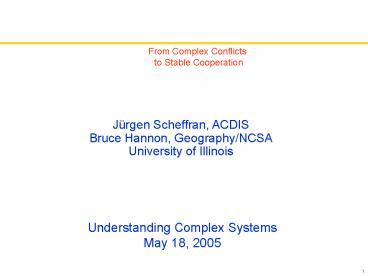Understanding Complex Systems - PowerPoint PPT Presentation
1 / 24
Title:
Understanding Complex Systems
Description:
The two-actor model in Stella. 10. The transition to chaos. Anti-symmetric case as a function ... Two actor model with different guardrails. Case 1 is baseline with: ... – PowerPoint PPT presentation
Number of Views:47
Avg rating:3.0/5.0
Title: Understanding Complex Systems
1
- From Complex Conflicts to Stable Cooperation
Jürgen Scheffran, ACDIS Bruce Hannon,
Geography/NCSA University of Illinois
Understanding Complex Systems May 18, 2005
2
What is conflict?
- Conflict Dynamic process involving actors which
fail to reduce their conflict potentials to
tolerable levels - Actors persons, groups, States, firms, etc.
- Conflict potential continued differences on
- Values/goals (interests, needs, motivations,
risks, objectives, targets) - Resources/means (cost, investment, time, energy,
information, force) - Options/actions (decision possibilities,
technology paths, behavior modes) - Conflict dynamics
- Conflict escalation actions lead to increasing
conflict potential (unstable) - Conflict resolution actions reduce conflict
potential (stable) - Cooperation actors achieve their goals better by
adapting their goals, means and actions
3
The action triangle
4
The single actor feedback loop
- Feedback/learning
priorities px
Max.cost C
efficiency fx
Value V Goal V
Cost C
System X
cx unit cost
vx unit value
C Cost invested in a given period (flow
variable) for changing system state x with fx
px vx / cx action efficiency, depending on unit
cost cx, unit value vx and px percentage of
cost allocated to action path x. k cost
reactivity in logistic reaction function ?
desired decay time of value gap
5
The multi-actor feedback loop
C1 Ci Cn
C1 Ci Cn
X1 Xk Xm
V1 -V1 Vi -Vi Vn - Vn
fij
pik
cik
vik
Invested Costs
System variables
Values goals
Efficiency
Allocation preferences
6
The multi-actor dynamic system
?Vi fij Cj ?Ci - ki Ci (Ci - Ci) (Vi
- Vi ??i ?Vi) ?Xik pik Ci / cik
Satisfaction ?Ci 0 for ?Vi -(Vi - Vi)
/??i ?Vi (exponential decay) Target costs for
?Vi ?Vi Ci (?Vi - fij Cj ) /
fii
7
Conflict vs. cooperation
Cost C2
Conflicting relation
Max C2
C
Neutral relation
C2
Cooperative relation
C1
Cost C1
Max C1
Target cost Ci (?Vi fij Cj) / fii
8
The interaction matrix
?V F C ?V
C1
Ci
Cn
V1 - V1
V2 - V2
Vn - Vn
-Equilibria, stability and complexity depend on
interaction couplings fij(p) and thus can be
controlled by changing action priority
p. -Stability depends on eigenvalues of
interaction matrix F(p) -Two player stability for
fii gt 0, fij lt0 and det F f11 f22 f12 f21 gt
0 -Non-linear case fij ?Vi/ ?Cj and F is
Jacobi-Matrix
9
The two-actor model in Stella
10
The transition to chaosAnti-symmetric case as a
function of decay time tau
Parameter setting Initial V1(0) -V2(0) -0.3,
C1(0) C2(0) 30 Impacts f11 f22 -f12
-f21 0.01 k1 k2 0.02, C1 C2 60
tau0
tau0.1
tau10
11
An unstable conflict
Parameter setting Initial V1(0) -V2(0) -0.3,
C1(0) C2(0) 30 Impact f11 f22 0.009, f12
f21 -0.011 k1 k2 0.02, C1 C2 60
12
CLIMATE CHANGE
- The growing conflict between emission trends and
targets
Emissions
Socio-economic trend
Disaster threshold?
Conflict Potential?
Viable emission targets
Time
13
Cost-regulated climate model in Stella
14
The reduced climate model
?F G ?C B F ? G ? (C C1) ?T ?
ln (C / C1) - ? (T T1)
- Greenhouse gas emissions G
- Cumulative emissions F
- CO2 concentrations C
- Global mean temperature T
C1 280 ppmv and T1 14.6 oC denote the
preindustrial levels
- ? Q2C / (coc ln 2) , ?? Q2C / (coc T2C )
- Q2C 3.7 W m-2 radiative forcing for doubling
concentration - coc 61.4 Wa m-2 oC-1 effective ocean heat
capacity - T2C ? 1.5oC, 4.5oC climate sensitivity (double
concentration)
Source Hasselmann etal 1997, Petschel-Held etal
1999, Kriegler/Bruckner 2004
15
Role of reduction costs per emission unit
- c0 100
- c0 200
- Baseline G07.5 GtC/a, ?G00.2 GtC/a, C50b,
c0100 b/GtC, ?0.017 (T2C3.5C). ?-0.5,
k0.001, ?100
- c0 20
- c0 50
16
Temperature change for parameter variations
200
10
150
20
100
50
50
20
100
200
Variation of unit reduction cost c0 b/GtC
Variation of max reduction cost C b/a
0.5
0.4
0.3
0.2
0.1
0
Variation of emission trend ?G(0) GtC/a
0
Variation of climate sensitivity T2C
17
Two-region climate model
18
Two actor model with different guardrails
- Case 1 is baseline with
- Actor 1 G106 GtC/a, ?G100.1 GtC/a, R140b,
T13 oC - Actor 2 G201.5 GtC/a, ?G200.1 GtC/a,
R210b, T21.5 oC
- Case 2 like case 1 with
- Actor 1 T11.5 oC
- Actor 2 T23 oC
19
FISHERY CONFLICTS
- 70 of fish stocks worldwide heavily
overexploited - Some of them collapsed or to be collapsed, e.g.
NorthwestAtlantic or North Sea cod - Low quality of management strategies
- High levels of subsidies
- Collective-action problem in common pool resource
(Tragedy of the commons) - Conflicts on scarce fish stocks
20
Fishery and socio-ecological interaction
Policy
r (K x) Fish productivity
? C Effective efforts
h Harvest
Technology Environment
21
Multi-actor competition in fishery
?
22
Baseline parameter set
6
0.2
23
Competitive fishery case
24
Cooperative fishery case































